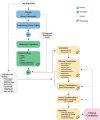Best practices for the analytical validation of clinical whole-genome sequencing intended for the diagnosis of germline disease
- PMID: 33110627
- PMCID: PMC7585436
- DOI: 10.1038/s41525-020-00154-9
Best practices for the analytical validation of clinical whole-genome sequencing intended for the diagnosis of germline disease
Abstract
Whole-genome sequencing (WGS) has shown promise in becoming a first-tier diagnostic test for patients with rare genetic disorders; however, standards addressing the definition and deployment practice of a best-in-class test are lacking. To address these gaps, the Medical Genome Initiative, a consortium of leading healthcare and research organizations in the US and Canada, was formed to expand access to high-quality clinical WGS by publishing best practices. Here, we present consensus recommendations on clinical WGS analytical validation for the diagnosis of individuals with suspected germline disease with a focus on test development, upfront considerations for test design, test validation practices, and metrics to monitor test performance. This work also provides insight into the current state of WGS testing at each member institution, including the utilization of reference and other standards across sites. Importantly, members of this initiative strongly believe that clinical WGS is an appropriate first-tier test for patients with rare genetic disorders, and at minimum is ready to replace chromosomal microarray analysis and whole-exome sequencing. The recommendations presented here should reduce the burden on laboratories introducing WGS into clinical practice, and support safe and effective WGS testing for diagnosis of germline disease.
Keywords: Genetic testing; Laboratory techniques and procedures; Next-generation sequencing.
© The Author(s) 2020.
Conflict of interest statement
Competing interestsS.L.T., R.J.T., and J.W.B. are current employees and shareholders of Illumina Inc.
Figures


Similar articles
-
Best practices for the interpretation and reporting of clinical whole genome sequencing.NPJ Genom Med. 2022 Apr 8;7(1):27. doi: 10.1038/s41525-022-00295-z. NPJ Genom Med. 2022. PMID: 35395838 Free PMC article. Review.
-
Cost-Effectiveness of Whole-Genome vs Whole-Exome Sequencing Among Children With Suspected Genetic Disorders.JAMA Netw Open. 2024 Jan 2;7(1):e2353514. doi: 10.1001/jamanetworkopen.2023.53514. JAMA Netw Open. 2024. PMID: 38277144 Free PMC article.
-
Clinical utility of genomic sequencing: a measurement toolkit.NPJ Genom Med. 2020 Dec 15;5(1):56. doi: 10.1038/s41525-020-00164-7. NPJ Genom Med. 2020. PMID: 33319814 Free PMC article. Review.
-
Test development, optimization and validation of a WGS pipeline for genetic disorders.BMC Med Genomics. 2023 Apr 5;16(1):74. doi: 10.1186/s12920-023-01495-x. BMC Med Genomics. 2023. PMID: 37020281 Free PMC article.
-
Meta-analysis of the diagnostic and clinical utility of genome and exome sequencing and chromosomal microarray in children with suspected genetic diseases.NPJ Genom Med. 2018 Jul 9;3:16. doi: 10.1038/s41525-018-0053-8. eCollection 2018. NPJ Genom Med. 2018. PMID: 30002876 Free PMC article.
Cited by
-
Molecular Characterization of Lineage-IV Peste Des Petits Ruminants Virus and the Development of In-House Indirect Enzyme-Linked Immunosorbent Assay (IELISA) for its Rapid Detection".Biol Proced Online. 2024 Jul 5;26(1):22. doi: 10.1186/s12575-024-00249-y. Biol Proced Online. 2024. PMID: 38969986 Free PMC article.
-
Genetic Landscape of Masticatory Muscle Tendon-Aponeurosis Hyperplasia.Genes (Basel). 2023 Aug 29;14(9):1718. doi: 10.3390/genes14091718. Genes (Basel). 2023. PMID: 37761858 Free PMC article.
-
Quality assurance within the context of genome diagnostics (a german perspective).Med Genet. 2023 Jun 13;35(2):91-104. doi: 10.1515/medgen-2023-2028. eCollection 2023 Jun. Med Genet. 2023. PMID: 38840862 Free PMC article.
-
Emerging technologies for prenatal diagnosis: The application of whole genome and RNA sequencing.Prenat Diagn. 2022 May;42(6):686-696. doi: 10.1002/pd.6146. Epub 2022 Apr 18. Prenat Diagn. 2022. PMID: 35416301 Free PMC article. Review.
-
Bioinformatics of germline variant discovery for rare disease diagnostics: current approaches and remaining challenges.Brief Bioinform. 2024 Jan 22;25(2):bbad508. doi: 10.1093/bib/bbad508. Brief Bioinform. 2024. PMID: 38271481 Free PMC article. Review.
References
Publication types
Grants and funding
LinkOut - more resources
Full Text Sources

